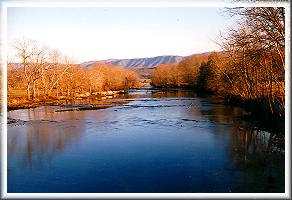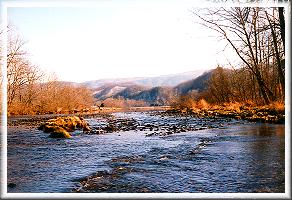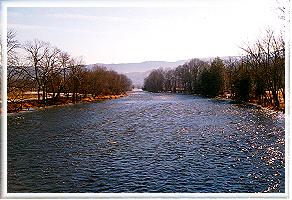|
Rainy Days and Sundays
A while back, I attempted to write an article on my experience
with light line fly-fishing. As is the norm with our New World
society, I received both praise and criticism from friend and foe
alike. Most of the praise came from those like myself enjoyed
the change of pace and who were catching all species of fish for
the first time in their life on a regular basis. The foes pointed out
that fishing with lines at or under a three weight was an
abomination in the eyes of the Almighty, and that the use of
lightweight systems suffer poor water creatures unmercifully.
Remember in the movie Smokey and the Bandit when
Old Bandit said something like, "you are only as smart as
where you happen to be standing?" So, I will address my
point of view primarily to those of us who live in the eastern
United States; particularly the southeast. Here on this side of
the mountains, I have had to learn to contend with put-and-take
mentalities, large groups of tourists who wade on redds, and
new inductees to fly tossing that can run through seven miles
of river like a Zulu warrior. I should not fail to recognize Grandpa
Poo who can throw a very large Rapala two hundred yards to
and through the pool that I always seem to be casting in.
Needless to say, my trout and other species stay in a condition
that would be best explained as clinically psychotic or near
collapse from paranoia. This general mental condition of my
local fisheries has been developed from the fish being stepped
on, depth charged, hammered, jet skied, and herded. In short,
I live in an area where fishing is hard. I had to either adapt to
the pressure or be very disappointed in my fishing success.
So, I am presenting a point of view supporting a lighter approach
to fly-fishing. I am here to present the viewpoint that people in
situations like mine might increase their success if they lighten up
a little. All that is required is a review of what works and the
tools utilized.
Rods, Reels, and Puppy Dog Tails
A review of my logs for the past three years fishing the rivers
and streams (that's Yankee for creek) of East Tennessee
confirmed a trend. Every time I kept my approach simple
and light, I caught fish. This included overcast or sunny days,
rainy or clear days, Canada Goose days, grandpa days, or
whatever. It may be a single fish day or fish the size of what
some would call bait, but I caught a fish on that day when no
others did. I believe that highly pressured fish can be taken
providing one concentrates on presentation, matches the rod
and reel system to the fish's attitude, and has confidence
based on a working knowledge of a particular environment.
I assume that 5-4 weight or lighter rods come to mind when
one hears someone say, "I'm going light!" Most writers and
experts that I read tend to put the 5-weight rod at the top
end of the light rods and the bottom end of medium rods.
There seems to be an increased interest in lighter rods and
fly lines as manufacturing materials improve with advances
in technology. I personally think lighter equipment is the
way to go to improve fishing success. No Martha, I am
not saying everyone should run out and buy a $1,000
2-weight system, but they would probably catch more
fish if they did.

My concept of fishing light is founded on solid fishing
techniques (knowledge of the subject species), dependent
on basics (knowledge of the principles of fly-casting
and presentation), and knowing how to conduct myself
on the water (the environment). I have adapted my approach
and equipment to meet my fishing requirements and conditions.
Since I can't find the "golden" fly rod that can cast mystic
powers over trout to jump on a fly, this approach seems to
be most logical.
As a beat to death and highly conditioned fly-fishing industry
consumer, I feel that I have achieved Jedi-like mastery in my
ability to make blunders. Trying to learn or obtain the latest
thing or trick in the wonderful world of fly-fishing does not
work. Yet, I love trying to break the code on what one thing
brings a good system together. I have concluded and feel very
strongly that the fly line is just about the most important factor
in creating the highly advertised and editorialized balanced
system.
I have noted on lighter weight systems, generally 4-weight
and lighter fly lines produced, with noted exceptions, have
a longer front taper. Being no expert and still trying to decode
the concepts of fly line design, I would think this would
provide for more close-in casting control and possibly more
delivery control of the line to the water. Also, the diameter
of lines is decreasing. Recently, I had to laugh when a cheap,
mass produced 4-weight rod & fly line out-performed a
high-cost consumer fly line of mine. The result was the
cheap line out-distanced and out-controlled the so-called
quality ($) product with little or no effort. I was extremely
pleased and impressed with the light water entry of the
4-weight line.
In mountain talk, fly lines are like puppies to me. Brittany puppies
tend to fly in general directions in response to the yells of their
handler and seem to point everywhere. However, only one pup
out of a litter will hunt well close and far. Around this neck of
the woods, choosing a good hunting dog from a pup is really
difficult. It's real easy to buy a bad dog when it was purchased
on the basis of pedigree alone.
Try to put as much research and trial into your fly line as
you would into a rod, reel, or hunting dog. I doubt if many
of you would ever admit to making a statement like, "I went
to Martha's Fly & Bait Shop to buy a new rod and reel for
my fly line." Yet, I have seen some friends here in East
Tennessee run right out to buy a $600 rod with a supersonic
$300 reel affixed based on a picture advertisement or
something they were told. When I ask them about the line,
they usually can't tell me a thing other than the brand name,
the shop put it on, or that it was $55. Worse, they purchased
a complete lightweight system without trying it out. If they
did try it out, trials with different lines never entered their
highly focused and consumer conditioned little heads.
I highly recommend that any rod system should be thrown
before the money is blown. This is especially true if any
high-cost, lightweight system is in your dreams. Don't just
walk outside the shop and throw a well-tutored loop or two
with your favorite salesperson. Before I will spend the better
part of a month's salary on a highly specialized lightweight
system, I want to try the weapon against the enemy. Ok, so
I have beaten the obvious to death. Then why do people
and my friends do it?
A light 4-weight or lighter rod is an out-of-body experience
for most. My initial tendency to over power my 2-weight
was great. So, you still want a lightweight. Then go to your
favorite fly shop and take a demonstrator rod to the river
or stream. See if you like the performance. Don't
be mesmerized by the name on the butt section, what you
read in an article, or the beautiful photo advertisement you
saw. Be objective and honest with yourself.
When you're on the stream, does that supersonic system
meet your requirements for casting control, water entry,
and just general fishing appeal? The Power Rangers among
you can add distance control, too. Ask for that
demonstrator rod people! Tell them that you'll bring it back
in a few days! Don't forget to take extra reels or spools
loaded with different lines from multiple manufacturers. I
recommend you try fly lines designed for lightweight rods
or in the smaller diameters.
What works best for me? My primary desire is a
system that I can control, enters the water with minimal
disturbance, and must have acceptable performance in a
moderate wind. Please note that distance did not appear
as a priority anywhere in the last sentence. In my mind,
there is no difference between a 3-weight and a 5-weight
if they both have equal water entry like a Mark 21 naval torpedo.
I never thought of maximizing my favorite 5-weight rod
for function and finesse. That was until I replaced a very
popular, highly advertised line with a line that actually matched
the rod's behavior and my casting style. The replacement fly
line was a lighter, smaller diameter line with a belly that
supported intermediate casting ranges and responded to
the medium-fast action of the rod. The change in line met
my need for stealth and supported my casting style.
The result was my level of confidence went way up, and I
have become master (in my own mind) of everything within
35 feet. This was acceptable to me since most of my
hookups are usually at a distance of 20 feet or less.
Leaders and tippets have always been a fun challenge for
rods under 4-weight. Most situations around home are
such that I am seldom required to continually change the
leader/tippet size and length. What am I trying to stay?
The stream's current flows, or lack of it, wind speed, the
stream's bottom structure and depth, the food chain in
the stream, and mental condition of my prey are fairly
predictable in my home waters. I usually do most of my
East Tennessee fishing with a minimum ten-foot leader
and a 6x tippet. Again, this is based on the highly predictable
gun-shy state of mind of a heavily pressured fish population
(and who are very discriminate eaters). I will only say the
leaders and tippets shall remain that continual, every
changing mystery for most fly fishers. I can only state
that long and light works in East Tennessee.
Relatives, Relationships, and Fights Around the Out House
Not understanding what the river or creek is telling me has
probably caused me more failures on the stream than
any other factor. Breaking the nature code depends on
what a section of water offers fish or man, or either
simultaneously. I wonder how many of us actually sit
down to consider the characteristics of depth, current(s),
vegetation (edge and sub-surface), and what native
creatures are present in and around the stream. Ever
watch a heron fish? This controversial subject has
enjoyed the favor of many an outdoor writer and kept
them well fed.
Really, how much time do you spend actually breaking
out where the trout lies are? Where are the canalizing
currents? How many of us actually check to see what
is present in the water? From the time the nun threw the
yarn and feathers in the water, the basic axioms of how
we understand a section of water is consistent until man
or nature changes the game plan.
My success rate is usually directly related to how much
time I spend listening to what Mamma Nature is telling me.
On my home waters, I try to make a conscious effort to
mentally break the water into sections of 20 x 20 feet.
Breaking a section of water into these blocks is the easiest
way to decide what to do about getting a fish on. Busting
vegetation and jumping into the water to get at one or two
raising fish may be the start of a very lean day indeed. I try
to work to an array of fish and not be tricked or drawn into
haste by a single rise form. I would love to have a dollar for
the number of times I have violated this. Just sit down and
watch awhile then enjoy one well-aimed cast with little
disturbance to the water above the trout or target species.
Bam!

On the ever so popular South Holston River, I continually
see people get out of the their Grand Cherokees, adorn
themselves with ten pounds of very shinny equipment, and
literally jump into the river without so much as looking up.
The visual wakes from retreating trout go in every direction
as they attempt to escape the individual's attempt at a stealthy
approach. Not to mention taking the trout in my section that
leave with their tormented cousins. Hence, I usually start a
gunfight with the individual about their stream etiquette, the
50-yard rule, and their birthright. I feel a duty to train my
fellow stream mates.
What is the best technique and frame of mind for fishing light?
Stay out of the water! Sure you paid good money for
those breathable waders, but they will never leak if you don't
get them wet (and you will catch more fish). Learn to
low-crawl to the water and watch. How many times have you
sat in the weeds or bushes and practiced you casting? Remember
all those articles and books that revealed the glories of fishing near
the streams edge? I have found it's true and deserves the most
delicate of touches when a feeding trout is in less than a foot
of water.
If you fish a river or stream system over a period of time,
you will soon learn what the food chain menu is over a
year's time. Keep logs, take samples, and learn what
organisms are present. I used to laugh at people who
carried entomology kits and suction out trout. I don't
laugh now, but I do smile more.
Poll Analysis, Psychologists, and Mental Patients
Let's face it, the pressure for those of us who fly-fish
is going to get worse. An ESPN commentator stated
that 39 million people would join the ranks of Outdoor
Consumers of America this year. People will spend more
money on fishing this year than any other type of outdoor
recreation. Today, people are smarter and loosing the fear
of the difficult. They think they want more challenges in
their life. I wonder how fly-fishing qualifies?

I fish three major rivers and have over 100 named creeks
near my home in East Tennessee. As Davy Crockett would
say, I am blessed with the meanest smallmouth bass, the ugliest
brown trout, and the most beautiful rainbow and brook trout
in the world. However, the fishing is getting harder because
of the pressure being placed on the streams. Last year, more
than 20,000 nice people traveled to the South Holston River
to fish an eight mile section of river, and 5,000 people paid
big bucks to drift a two-mile section of the Watauga River
for a trophy trout (I don't worry much; they seldom
catch anything).
Pressure and people factors made me change my style of
fishing. I love to fish a 2-weight system on my local rivers and
streams. Equally, I have discovered that an over-three-pound
smallmouth on a 4-weight is the most fun I have ever had
while fully dressed. Life with a single fly box containing an
ensemble of flies matched to a stream is freedom (freedom
of movement and from a 10-pound vest). When the wind
blows hard, the heavy nine-foot long, 5-weight rod is the
only change to my battle dress. I also discovered that I
seldom carry a fly now over size #12, and most are size #16
and smaller. I found that I had not lived a full life until I
fished midges in a snowstorm.
Thank You Bernard
Will a lightweight approach work for you? I can't guarantee
results where you live, but it sure does work for me in East
Tennessee. The light or featherweight approach is not new.
Some fear that a lighter outfit will not handle a larger fish or
worry that lighter tackle will place a larger fish in jeopardy.
Education and experience will remove these fears. Both
Dave Whitlock and Lefty Kreh have written many a fine
article on how to fight, land, and handle larger fish on
lightweight gear. It works!
The first weeks in June of this year, I was sneaking off to
a park near my home at sunset. Since I could not make it
up river for trout, I thought some smalljaw action after the
personal watercraft went home would be good for the soul.
I consistently landed some well over 2-pound smallies (one
over four) with my 4-weight and began to draw a regular
crowd. After a couple of days of repeating my little sunset
show, two locals began to religiously show up to learn how
to fly fish. They both expressed a desire to fly fish for trout.
After listening to my dissertations, one of the two went to a
local fly shop to purchase an intermediate rod for general East
Tennessee fly-fishing. I recommended starting with a 5-weight,
but they sold him a 7-weight with a double taper fly line because
he used the word bass in a sentence. I sent him back.
If you fish eastern rivers and streams, I recommend that you
review your own fishing techniques and personal requirements.
I am certain that if you lighten up a bit, you just might smile
more. I am not after the biggest fish or the most. I just enjoy
the satisfaction of carrying everything in a single pocket and
not making waves. ~ Mike Widener (The Ridge Runner)
|




